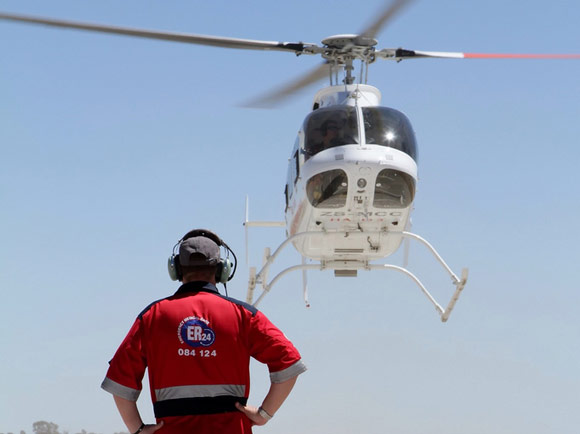 In Case Of An Accident
In Case Of An Accident
ER24 Emergency Helicopter Service provides expert medical care to critically injured patients in their hour of need.
The ER24 AER24 Medical Helicopters are equipped with state-of-the-art medical equipment and crewed with highly skilled paramedical crew; the goal being to provide the best possible care to patients when they need it most.
Patients are flown from a variety of different locations and incident types, including road accidents, near drowning incidents, pedestrian accidents, crime-related incidents and patients with medical emergencies. An inter-hospital transport facility is also available for critically ill patients who need to be moved between two medical facilities for specialised treatment.
Patients will be airlifted from the scene of an incident once medical personnel have assessed them, and only if they fall within pre-determined, evidence-based, best-practice medical criteria. This ensures that the helicopter is only sent to patients who are in critical need of specialised air transport and to situations where the flight and crew will confer maximum benefit.
Flight Crews are specifically trained for the Aeromedical environment and have to undergo a yearly flight medical to ensure that they are mentally and physically able to cope with the stressors induced by flight.

Helicopters have limitations like poor weather, distance to be covered and space and weight limitations. Only one patient can be flown at any one time, and there are times when more than one medical helicopter is dispatched to a scene, or the helicopter returns to collect another patient.
Safety around a helicopter is paramount. Here are a couple of points that the public should bear in mind if they happen to be on an accident scene and the helicopter arrives:
- No one should ever approach a helicopter without the go-ahead from the pilot or medical crew on board - ALWAYS approach the helicopter from the front.
- NEVER approach a helicopter from the back where the tail rotor is located.
- ALWAYS approach a helicopter in a slightly crouched position.
- NEVER approach the helicopter while the blades are still turning.
- Be aware that the helicopter might land on a slope and that the blades can droop down quite significantly causing a fatal accident.
A patient will always be flown to the nearest, appropriate, medical facility which can provide the best possible treatment for a specific illness or injury. This facility may be a private or a provincial hospital. This decision is made by the Chief Medical Officer after the nature and severity of the patient’s injury or illness have been carefully and thoroughly assessed. All patients are stabilized before flight and are comprehensively monitored in flight using advanced non-invasive monitoring equipment. The flight paramedics take stewardship of the patient’s care during the mission and hand over the patient to the receiving hospital medical team.
ER24 is proud to provide real help fast at a whole new level and promises to deliver fast and efficient emergency medical care.
Since August 2012, ER24 has developed strategic partnerships with various entities, which together to date provide Helicopter Emergency Medical Services using five aircraft provided by Halo Aviation, across the country. ER24’s ER1 is based at Lanseria airport in Johannesburg while three others operated in connection with the Department of Health, are based in Nelspruit, Bloemfontein and the North West and the latest addition operated in conjunction with SACAN is based at the Oribi airport in Pietermaritzburg.

Medical Guidelines
- Head injuries where the initial GCS is no less than 6 and no more than 12, with focal neurological deficit.
- Systolic blood pressure of less than 80 mm Hg systolic, despite fluid resuscitation.
- Where signs and symptoms indicate a spinal injury and where road transport, exceeds 20 minutes or where extreme terrain prevents safe ground transportation.
- Patients with respiratory distress despite supplemental oxygenation.
- Threatened limbs and/or amputations above the elbow or knee, with significant vascular compromise.
- Severe penetrating injury trauma to the head, neck, and thorax.
- Near drowning - where the patient remains unstable despite initial care.
- Electrocution with unstable arrhythmia or neurological deficit.
- Hypothermia (<35 °C) or hyperthermia (>40 °C).
- Burns - in adults with 30-80% BSA - in children with 20-80% BSA - burns to the face, with actual or potential airway compromise.
- Medical patients where the expertise of the crew is required:
- Unstable myocardial infarction
- Unstable arrhythmia
- Refractory anaphylaxis
- Refractory seizures

The Famous Six
The Famous Six is intended as a series of questions that can be asked by an emergency care practitioner in the pre-hospital setting to determine the viability of HEMS vs. ground transportation of a patient.
- Does your patient require medical resources that are critically time-dependent?
- How long will it take for you to begin your journey with the patient to a facility that will provide this intervention?
- Does the road surface that you intend to take to the hospital impact deleteriously on your patient's condition?
- Will the HEMS provide you with experience/expertise that will dramatically assist you in the management of the patient?
- Do you rapidly require more Advanced Life Support to manage your patient's condition and or the number of patients you face?
- Does your patient meet the clinical criteria for HEMS identified in the dispatch guidelines?
For more information email Medicopter@er24.co.za or contact 0861 084 124. For all medical emergencies and flight activation requests, contact 084 124

Also visit the following sections:
Aerocare, Emergency Medical Air Evacuation and Road Safety
Accident Scene Safety
Identification of a Patient
Legal Duties and Advice
Post Traumatic Stress
Trauma Counseling
Road Safety And Response Time To Accidents
CrisisOnCall , Emergency Roadside Assistance and Road Safety
